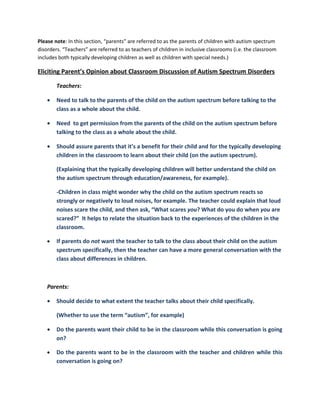
Eliciting Parent’s Opinion about Classroom Discussion of Autism Spectrum Disorders
- 1. Please note: In this section, “parents” are referred to as the parents of children with autism spectrum disorders. “Teachers” are referred to as teachers of children in inclusive classrooms (i.e. the classroom includes both typically developing children as well as children with special needs.) Eliciting Parent’s Opinion about Classroom Discussion of Autism Spectrum Disorders Teachers: • Need to talk to the parents of the child on the autism spectrum before talking to the class as a whole about the child. • Need to get permission from the parents of the child on the autism spectrum before talking to the class as a whole about the child. • Should assure parents that it’s a benefit for their child and for the typically developing children in the classroom to learn about their child (on the autism spectrum). (Explaining that the typically developing children will better understand the child on the autism spectrum through education/awareness, for example). -Children in class might wonder why the child on the autism spectrum reacts so strongly or negatively to loud noises, for example. The teacher could explain that loud noises scare the child, and then ask, “What scares you? What do you do when you are scared?” It helps to relate the situation back to the experiences of the children in the classroom. • If parents do not want the teacher to talk to the class about their child on the autism spectrum specifically, then the teacher can have a more general conversation with the class about differences in children. Parents: • Should decide to what extent the teacher talks about their child specifically. (Whether to use the term “autism”, for example) • Do the parents want their child to be in the classroom while this conversation is going on? • Do the parents want to be in the classroom with the teacher and children while this conversation is going on?
- 2. The Talk: Issues Teachers Should Consider Respect and Understanding of Differences • It’s a good idea to have children in the class talk about their strengths and weaknesses In elementary school, for example, academics and social learning occurs. It’s helpful for children to talk about the areas that are easier and harder for them in terms of academic and social learning. A child in class might express that he finds some aspects of math to be a challenge. The teacher can point out that the child on the autism spectrum finds communicating with other children to be a challenge, for example. The teacher should point out that everyone has something to work on/something that they find to be challenging. Safety • Children need to feel safe. It is important that the teacher makes it very clear to the children in their class that they are safe • They also need to know that the teacher is safe and child on the autisim spectrum is safe. For example, the child on the autism spectrum might display aggressive behavior and/ or is being restrained. The other children need to know that the child on the spectrum is being kept safe, and that they and the teacher and will be kept safe as well. • The children need to know that the teachers are in control of the situation. References
- 3. Interview with Darilyn Donovan, Principal of the Lowell Elementary School, Watertown, MA. Interview with Patricia Torchio, First grade teacher at the Hosmer Elementary School, Watertown, MA.
